Birdfinding.info ⇒ Generally uncommon across most of its large range, but locally common in Senegambia, the Great Lakes area; the Zambezi River depression, and northeastern and coastal South Africa. Some sites where it is often found include: in Senegal, Les Trois Marigots and Oiseaux du Djoudj National Park; in Egypt, the Aswan Dam area; in Kenya, Nairobi National Park; in Tanzania, Lake Manyara; and in South Africa, Marievale Bird Sanctuary, Wilderness National Park, and various wetlands around Cape Town.
African Swamphen
Porphyrio madagascariensis
Africa and Madagascar. Widespread across much of sub-Saharan Africa from southwestern Mauritania, southern Mali, Chad, and Ethiopia south to Cape Town, and east onto Madagascar. Also north in the Nile Valley to the Mediterranean coast of Egypt.
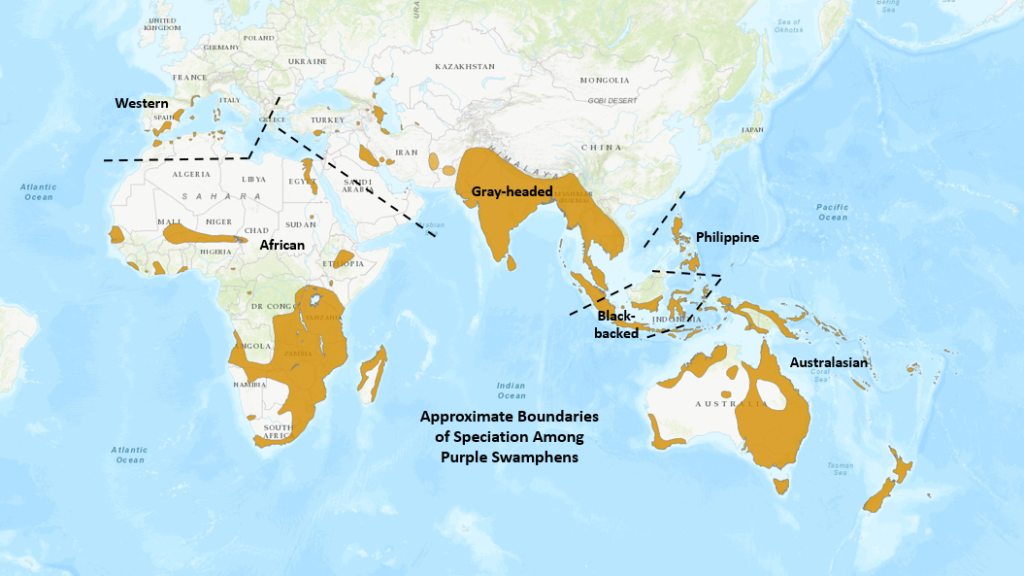
Approximate distribution of the African Swamphen in Africa and Madagascar. © BirdLife International 2019
Somewhat regular as a vagrant or irruptive visitor northeast into Israel—where it may be in the process of establishing a permanent population. Wanderers also occur, and have bred, along the Persian Gulf coast to Qatar and the United Arab Emirates (where Gray-headed Swamphen is resident). Reports from the Canary Islands and Azores might refer to either African or Western Swamphens.
A putative record from Bermuda in October 2009 seems to have been misidentified, apparently a Gray-headed Swamphen that presumably arrived from the rapidly expanding introduced population in Florida, which has produced at least one other Bermuda record. (See Notes below: 2009 Swamphen Record from Bermuda Was Gray-headed, Misidentified as African.)
Identification
A large, long-legged gallinule that is mostly deep violet, becoming blackish on the belly, paler blue from the face and throat down to the chest, and a blend of greenish, brownish, olive, and turquoise on the back and adjacent upperparts.
Heavy triangular bill and smooth triangular forehead shield are red, varying from dull-pink or orange to scarlet, sometimes with darker stains of burnt-red.
Legs are all-pink, lacking the darker joints of most other swamphens.

African Swamphen. (Marievale Bird Sanctuary, Gauteng, South Africa; March 3, 2012.) © Mark Samuelsson

African Swamphen. (Marievale Bird Sanctuary, Gauteng, South Africa; August 4, 2018.) © Richard Gray

African Swamphen. (Milnerton, Cape Town, South Africa; October 15, 2017.) © Philip Herbst
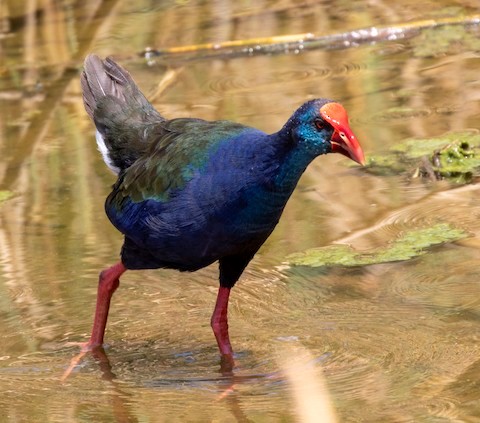
African Swamphen. (Reitvlei, Pretoria, South Africa; October 16, 2019.) © Marie Lister
Upperparts coloration varies widely. Some individuals have vivid green, olive, or bronze on their backs. Some individuals have mostly dark or violet upperparts, with only limited traces of brown, olive, or green—and are therefore easily confused with Western Swamphen (see below).
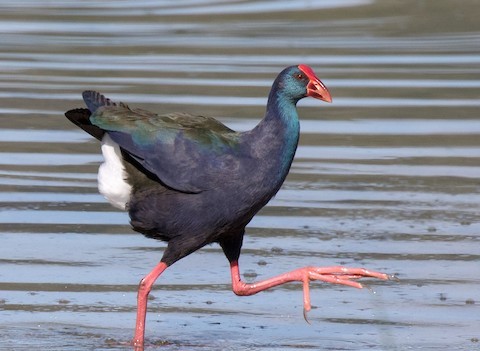
African Swamphen, showing mostly violet wings and olive back. (Rondevlei, Wilderness National Park, Western Cape, South Africa; April 8, 2017.) © Bruce Ward-Smith
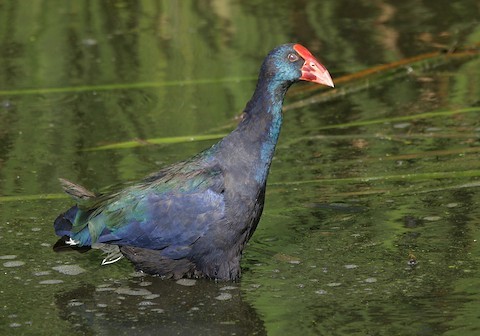
African Swamphen, a dark individual with a subtle green tint on the back. (Paarl Bird Sanctuary, Western Cape, South Africa; December 29, 2004.) © Keith CC Mitchell
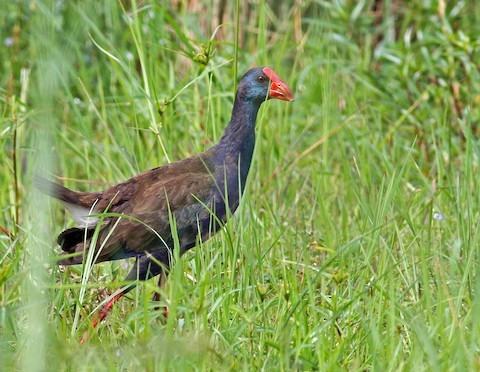
African Swamphen with a brown back. (Shamvura Camp, Kavango East, Namibia; December 4, 2014.) © Frans Vandewalle
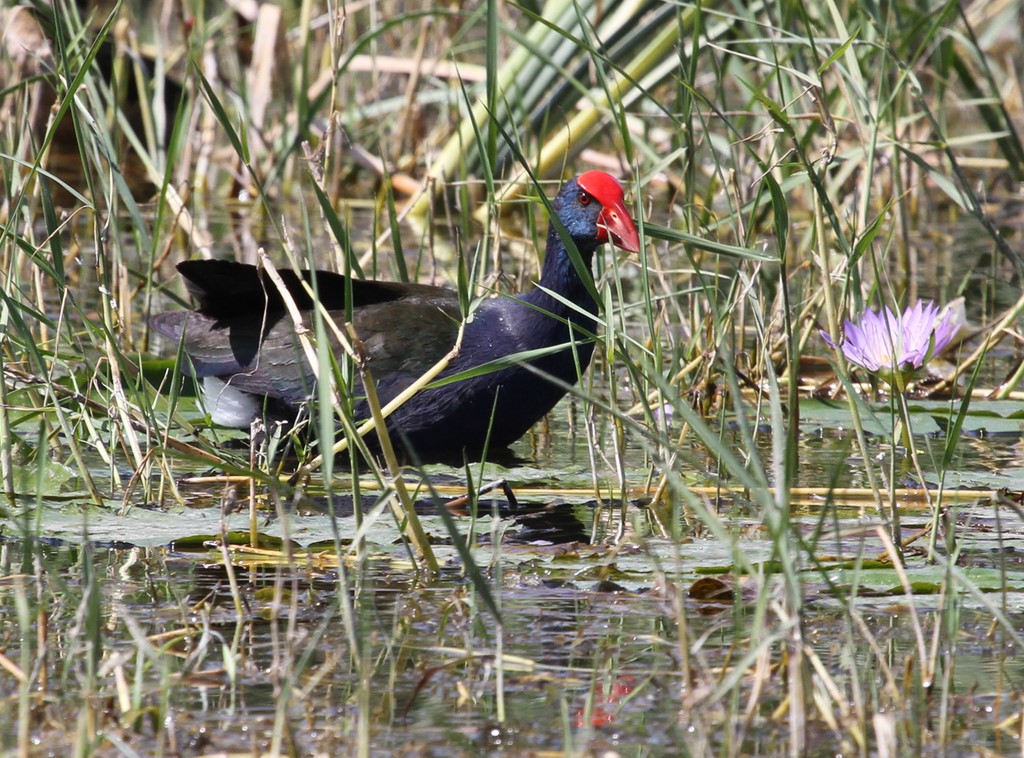
African Swamphen, showing an apparently black back. (Awasa, Ethiopia; December 28, 2012.) © wildchroma

African Swamphen with dull-olive upperparts. (Livingstone Treatment Ponds, Zambia; August 12, 2019.) © Charles Vellios

African Swamphen, showing an all-dark back. (F-Nord Lake, Nouakchott, Mauritania; November 10, 2016.) © Robert Tovey

African Swamphen, showing mostly greenish-blue upperparts. (Hod hasharon Constructed Wetland, HaMerkaz, Israel; September 18, 2017.) © Rami Derech
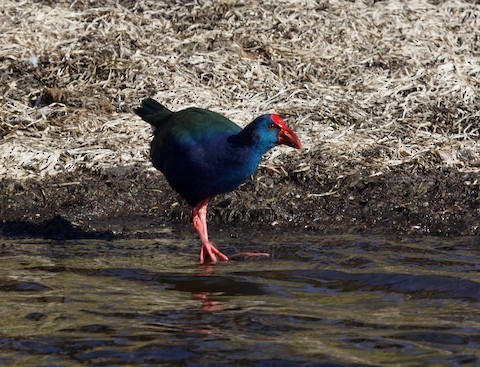
African Swamphen with mossy-green back. (Kitchener’s Island, Aswan, Egypt; December 30, 2018.) © Liam Ragan
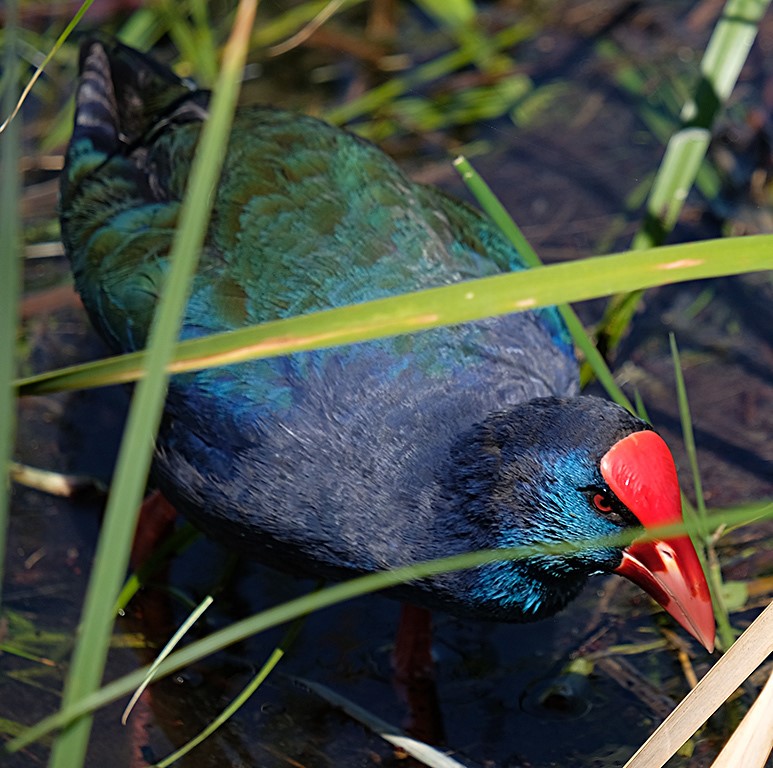
African Swamphen. (Wilderness National Lakes Area, Western Cape, South Africa; September 22, 2020.) © Leonie Twentyman Jones

African Swamphen, bluer than average. (Belas, Angola; September 8, 2019.) © Rogério Ferreira
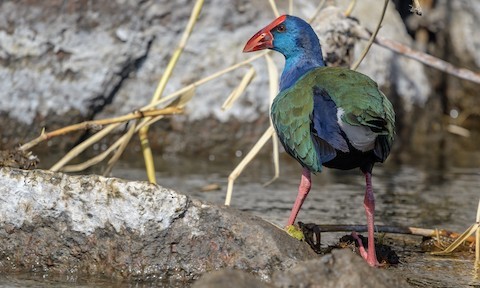
Gray-headed Swamphen showing typical but especially vivid plumage: mostly purplish and turquoise, with a whitish-gray head. (Little Andaman Island, India; February 21, 2019.) © Stanislav Harvančík

African Swamphen, a vividly olive-backed individual. (Cape Town, Western Cape, South Africa; July 16, 2020.) © Timothy Whitehead
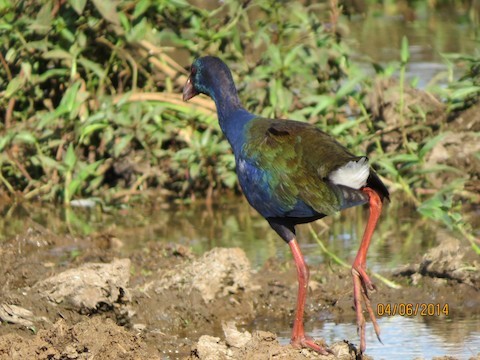
African Swamphen, showing a bronzy back. (Hyena Dam, Nairobi, Kenya; April 6, 2014.) © James Kashangaki

African Swamphen, showing bright-bronze upperparts. (Wakkerstroom Wetland Nature Reserve, Mpumalanga, South Africa; October 17, 2014.) © Nancy Cox
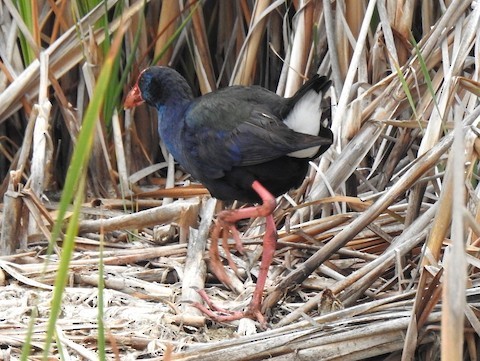
African Swamphen, showing an apparently black back. (West Coast National Park, Western Cape, South Africa; February 20, 2019.) © Bob Butler
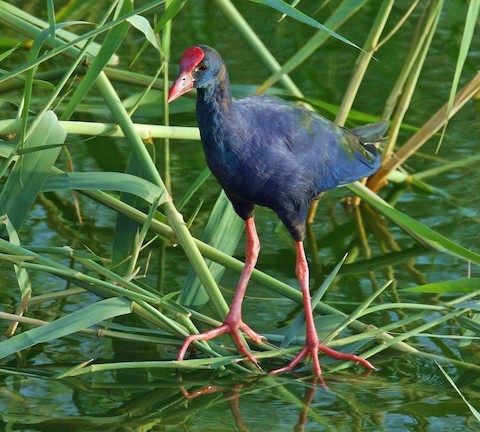
African Swamphen with mostly blue upperparts, showing only subtle traces of green on the back. (Abu Nakla Sewage Treatment Plant, Qatar; June 23, 2009.) © John Thompson
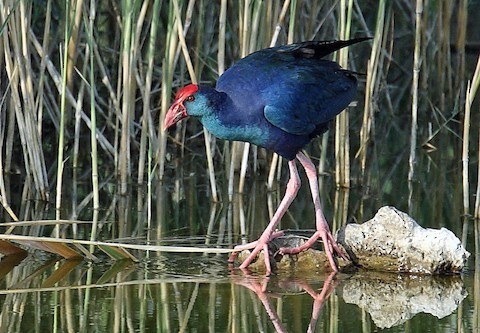
African Swamphen with mostly blue upperparts, showing only subtle traces of green on the back. (Abu Nakla Sewage Treatment Plant, Qatar; May 27, 2009.) © John Thompson
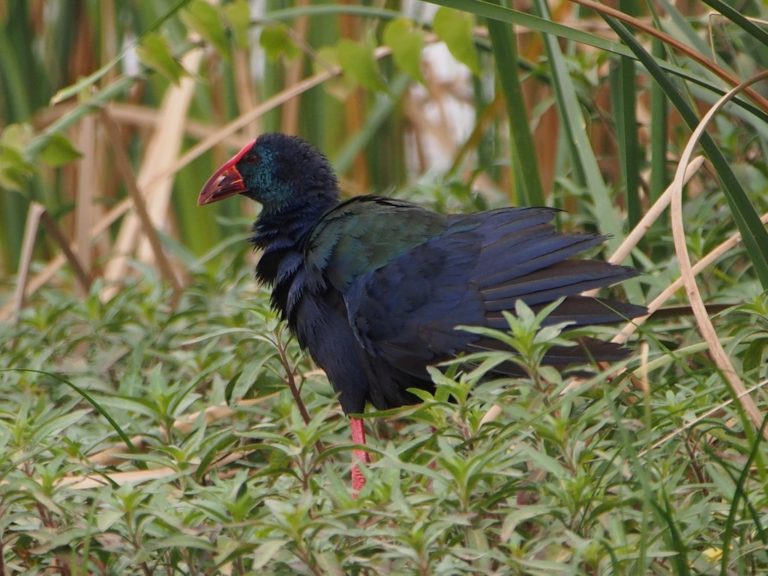
African Swamphen, a dark individual with a dark-green back. (Dagana, Senegal; January 22, 2020.) © Marco Rastelli
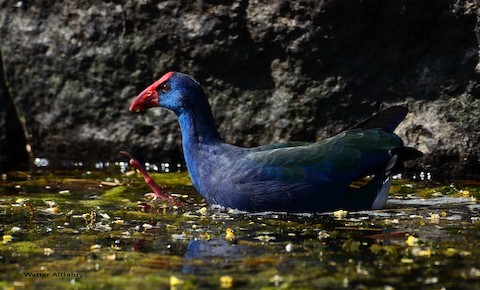
African Swamphen with mossy-green back. (Kitchener’s Island, Aswan, Egypt; December 7, 2019.) © Watter AlBahry
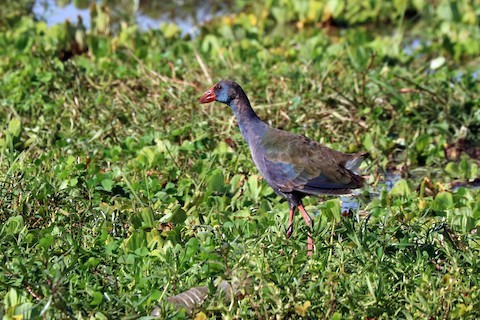
African Swamphen, mostly violet with brownish upperparts. (Lake Manyara National Park, Tanzania; July 19, 2019.) © Colin Sumrall
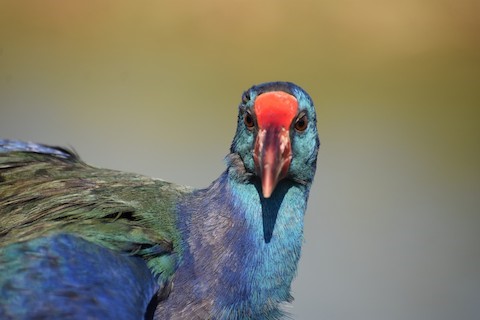
African Swamphen. (Eilat, Israel; October 16, 2018.) © Ky Clare
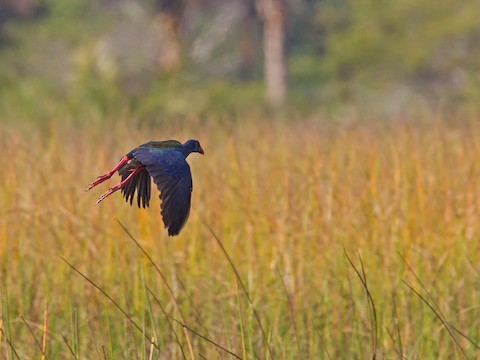
African Swamphen, showing dark-greenish back and violet on spread wings. (Panda-Inharrime Wetlands, Inhambane, Mozambique; August 10, 2013.) © Niall D. Perrins

African Swamphen, showing olive back and violet on spread wings. (Rondevlei, Wilderness National Park, Western Cape, South Africa; April 8, 2017.) © Bruce Ward-Smith

African Swamphen, showing greenish back and violet on spread wings. (Karaman Island, Suhaj, Egypt; October 27, 2016.) © Watter AlBahry
Juveniles are mostly pale-gray with black bills and blue on the wings. As the immautres age into subadulthood, dark-blue feathers grow in and the back becomes extensively brown.

African Swamphen, juvenile. (Abu Nakla Sewage Treatment Plant, Qatar; May 25, 2009.) © John Thompson

African Swamphen, juvenile. (Kommetjie, Cape Town, South Africa; November 19, 2017.) © Adam Welz
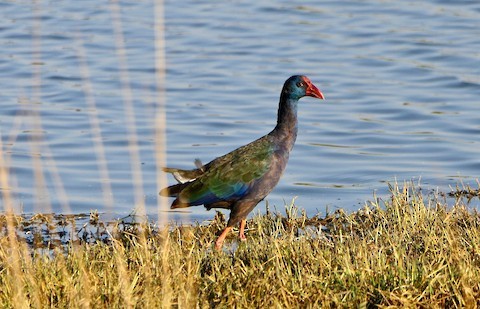
African Swamphen, colorful subadult. (Bullfrog Dam, Gauteng, South Africa; May 24, 2018.) © Neil Broekhuizen

African Swamphen, probable subadult showing extensively brown upperparts. (Marievale Bird Sanctuary, Gauteng, South Africa; July 6, 2018.) © Dan Vickers

African Swamphen, juvenile. (F-Nord Lake, Nouakchott, Mauritania; March 26, 2017.) © Robert Tovey
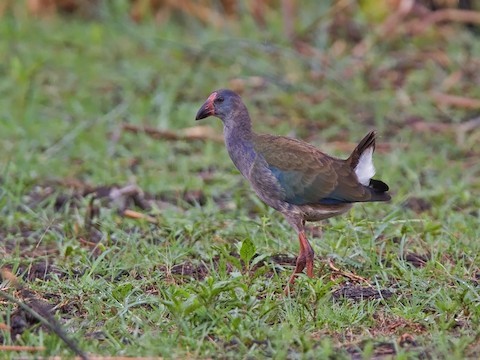
African Swamphen, immature. (Mkhombo Nature Reserve, Mpumalanga, South Africa; December 22, 2011.) © Niall D. Perrins
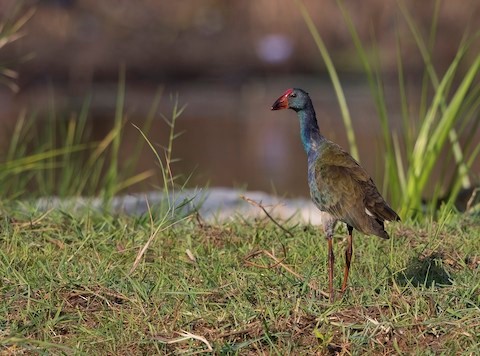
African Swamphen, subadult with brown back. (Okavango Delta, Botswana; October 30, 2016.) © Niall D. Perrins

African Swamphen, colorful subadult. (Salouga and Ghazal Nature Reserve, Aswan, Egypt; December 7, 2019.) © Watter AlBahry
Cf. Western Swamphen. African and Western Swamphens potentially overlap in northwestern Africa and through more long-distance vagrancy in Macaronesia and the Mediterranean region. They can be very similar, as they share the same coloration and pattern including all-pink legs (lacking the darker joints of all other swamphens).

African Swamphen, a dark individual with a subtle greenish tint on the back. (Paarl Bird Sanctuary, Western Cape, South Africa; December 29, 2004.) © Keith CC Mitchell
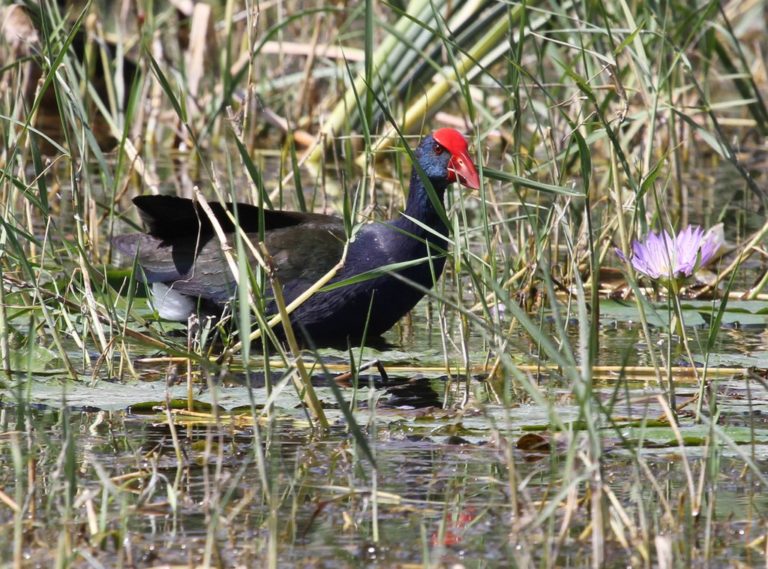
African Swamphen, showing an apparently black back. (Awasa, Ethiopia; December 28, 2012.) © wildchroma

African Swamphen with mostly blue upperparts, showing only subtle traces of green on the back. (Abu Nakla Sewage Treatment Plant, Qatar; May 27, 2009.) © John Thompson

African Swamphen, showing an apparently black back. (West Coast National Park, Western Cape, South Africa; February 20, 2019.) © Bob Butler
The coloration of the back appears to be the only consistent difference, and it is not always obvious. Western is essentially all-dark, blackish or violet, whereas African is some shade or mixture of greenish, brownish, and turquoise. However, on some Africans the color is so muted that it may simply appear dark, and some are more extensively violet, with only subtle traces of green and brown. Western may be distinguished on the basis that its upperparts are uniform and concolor with the underparts—whereas African’s upperparts tend toward dark-brown or blackish, and usually not the same as the violet on the neck and underparts.
(Some photographs from western Africa and Israel that have been posted online and identified as African Swamphens seem to have all-dark backs, which raises doubt as to whether some are actually Africans with darker-than-average backs, or wandering Western Swamphens, or possibly hybrids.)

Western Swamphen, showing blackish-violet upperparts. (S’Albufera, Mallorca, Spain; September 22, 2018.) © Guido Bennen
Notes
Monotypic species.
Traditionally considered conspecific with Western (porphyrio), Gray-headed (poliocephalus), Black-backed (indicus), Philippine (pulverulentus), and Australasian (melanotus) Swamphens, collectively known as the Purple Swamphen (Porphyrio porphyrio). (See Frontiers of Taxonomy: Parsing the Purple Swamphens.)
2009 Swamphen Record from Bermuda Was Gray-headed, Misidentified as African.
A swamphen discovered on Bermuda on October 23, 2009, has been accepted as the first North American record of African Swamphen (P. madagascariensis), but the photographs show features that are more consistent with Gray-headed Swamphen (P. poliocephalus), which has an expanding introduced population in Florida. Another likely member of the Florida population, but with an unambiguously gray head, appeared on Bermuda in late October of 2016, seemingly repeating the pattern of the 2009 bird.
Various reviewers have focused on the colors of the head (two shades of blue) and wings and back (largely turquoise and brown), and concluded that they rule out all the other swamphens and confirm its identity as African. To the contrary, however, despite the name, it is not rare for Gray-headed Swamphens to have all-blue heads of approximately the same coloration as the bird in the photograph.
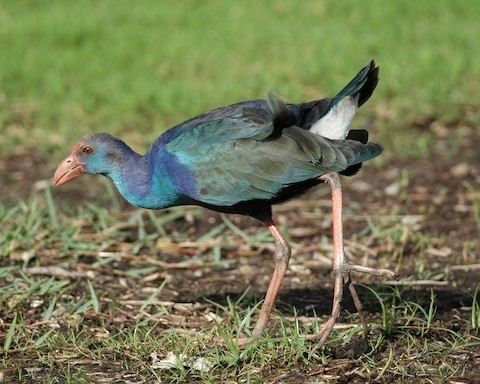
Likely Gray-headed Swamphen—identified and accepted as the first North American record of African Swamphen, but note its dark joints and largely turquoise wings, which indicate Gray-headed, not African. (Bernard Park, Bermuda; October 26, 2009.) © Andrew Dobson
The photograph shows two additional features that are not consistent with African, but effectively confirm its identity as Gray-headed. First, the legs are pink with darker joints, which rules out both African and Western Swamphens. Second, the wings and back are turquoise and brown, which is typical of Gray-headed but would be abnormal for African. Although African’s upperparts vary, which complicates the analysis, in general its wings and back become mostly brown during subadulthood, then the back becomes greenish-brown or olive and the wings become violet or indigo.
Peculiarly, the American Ornithological Society’s Committee on Classification and Nomenclature accepted the record as the first documented North American occurrence of African Swamphen (or at least of madagascariensis, but separately rejecting its status as a species). What appears to have happened is that unawareness of the broad variability in Gray-headed Swamphen led the observers and reviewers to rule out that identification, which left them open to regarding the back, wings, and leg colors and patterns as being approximately consistent with African without carefully scrutinizing them. As the Committee also rejected the proposed split of the Purple Swamphen that separates African from Gray-headed, it may have relegated identification on the subspecies level to rough probability instead of attempting a more rigorous analysis.
References
BirdLife International. 2019. Porphyrio porphyrio (amended version of 2016 assessment). The IUCN Red List of Threatened Species 2019: e.T22692792A155531172. https://dx.doi.org/10.2305/IUCN.UK.2016-3.RLTS.T22692792A155531172.en. (Accessed September 25, 2020.)
eBird. 2020. eBird: An online database of bird distribution and abundance. Cornell Lab of Ornithology, Ithaca, N.Y. http://www.ebird.org. (Accessed September 25, 2020.)
Garcia-del-Rey, E. 2011. Field Guide to the Birds of Macaronesia: Azores, Madeira, Canary Islands, Cape Verde. Lynx Editions, Barcelona.
García-R., J.C., and S.A. Trewick. 2015. Dispersal and speciation in purple swamphens (Rallidae: Porphyrio). Auk 132:140-155.
Hollom, P.A.D., R.F. Porter, S. Christensen, and I. Willis. 1988. Birds of the Middle East and North Africa. T & AD Poyser, Calton, England.
Mullarney, K., L. Svensson, D. Zetterström, and P.J. Grant. 1999. Birds of Europe. Princeton University Press.
Ripley, S.D. 1977. Rails of the World: A Monograph of the Family Rallidae. David R. Godine, Publisher, Boston.
Sinclair, I., P. Hockey, W. Tarboton, and P. Ryan. 2011. Birds of Southern Africa (Fourth Edition). Random House Struik (Pty) Ltd. Cape Town, South Africa.
Taylor, B., and B. van Perlo. 1998. Rails: A Guide to the Rails, Crakes, Gallinules, and Coots of the World. Yale University Press.
van Perlo, B. 1999. Birds of Southern Africa. Princeton University Press.
van Perlo, B. 2002. Birds of Western and Central Africa. Princeton University Press.
Xeno-Canto. 2020. African Swamphen – Porphyrio madagascariensis. https://www.xeno-canto.org/species/Porphyrio-madagascariensis. (Accessed September 25, 2020.)
